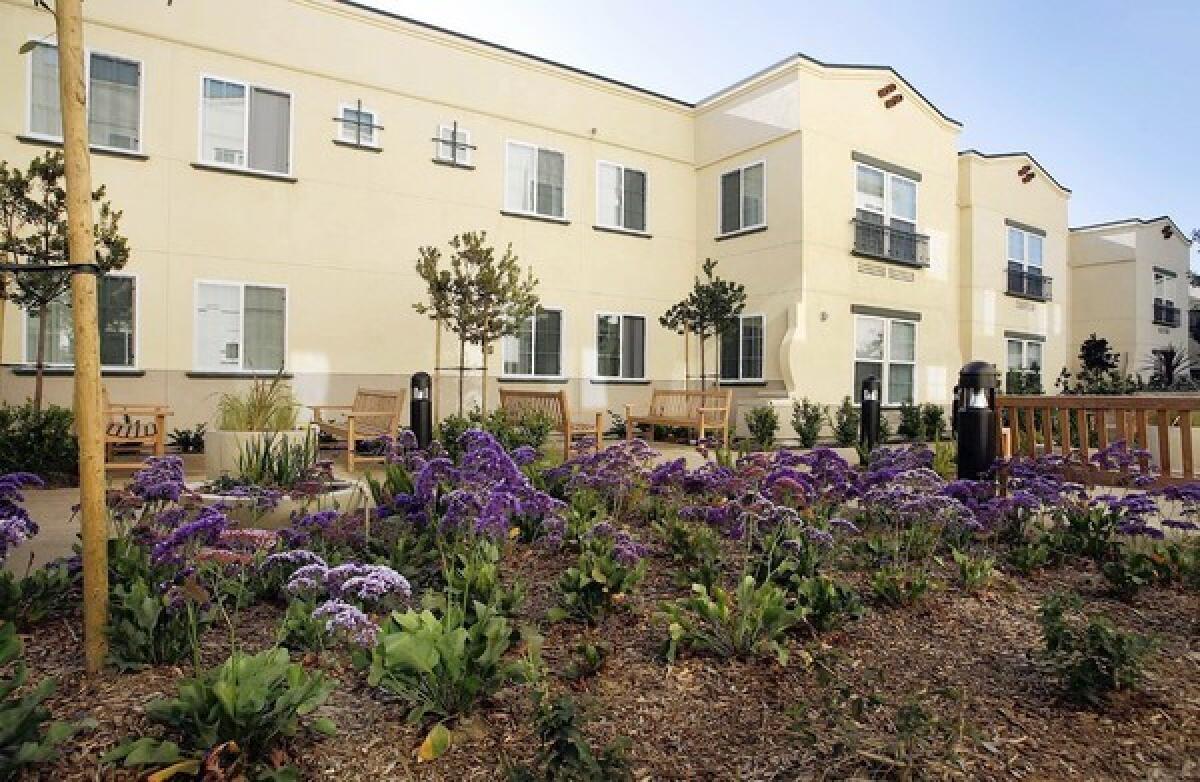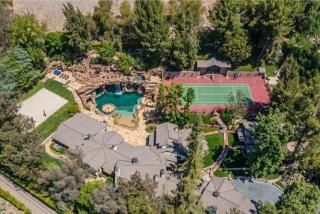Affordable housing goes green too

During a tour of his new East Rancho Dominguez apartment, Octavio Reyna paused proudly at his low-flow toilet.
“Two kinds of flush,” he said, gesturing to the buttons on top of the shiny white porcelain and delicately leaving the specifics to his guest’s imagination.
Then he was on to the bathtub, where “it’s in our contract that we can’t change the shower head,” then the kitchen, with its shiny floor that is “green-friendly,” and then the living room, where an energy-guzzling air conditioner was conspicuously absent.
Reyna, his wife and two children have been living at Casa Dominguez for only a few weeks, but already their view of the environment and their place in it has changed. They use eco-friendly cleaning products, are recycling for the first time in their lives and have become conscious of how much water and energy they use.
It is a transformation taking place up and down the quiet corridors of the 70-unit affordable housing project that has risen on a grubby stretch of Atlantic Avenue near the Compton border.
Like the Prius and the $5 locally grown heirloom tomato, green building has been a status symbol among the wealthy. Affordable housing, on the other hand, typically has been made as economically as possible — the better to provide homes for as many people as possible. Green touches have long been a luxury.
Casa Dominguez is one of a number of new developments signaling a change. The $31-million project, built by the Los Angeles-based affordable housing developer Abode Communities, is aiming to be the first multifamily affordable housing project in Los Angeles County to win the Leadership in Energy and Environmental Design platinum certification, the U.S. Green Building Council’s highest LEED rating.
The building was constructed with a prefabricated framing system that reduced waste. An on-site healthcare clinic and a child-care center lessen residents’ need to drive. The playground surface is made from recycled tires, and drought-tolerant landscaping is irrigated with gray water from the washing machines.
Common areas are solar-powered, and residents are kept comfortable in winter with hydronic climate control, meaning the water-heating system also helps to keep apartments warm. There is no air conditioning; instead, units have ceiling fans, and the building is designed to capture breezes and keep air circulating in a way that provides natural cooling in summer.
The flooring is low-emission tile free of polyvinyl chloride, Energy Star lighting uses compact fluorescent bulbs, and the walls’ blow-in insulation is composed of recycled material.
Robin Hughes, the president of Abode, said this kind of green affordable housing is a form of social justice.
“Sustainability practices should be something we embrace no matter what income level we are at,” she said. “By living at Casa Dominguez, families have the opportunity to be informed and educated and then embrace sustainable practices in their own lives.”
Rents range from $396 a month for a one-bedroom to $1,279 for a four-bedroom. Most families earn less than 50% of the area’s median income, which is about $79,000 for a family of four. The project also offers units to youth transitioning out of foster care; for many, it is their first permanent home. Nearly 1,000 people applied for the 70 spots.
Hughes added that she hopes the clean, sand-colored buildings and tasteful landscaping will spark a revitalization of the neighborhood. She said the child-care center and clinic, which will be operated by St. John’s Well Child and Family Center, will be available not only to residents but also to the surrounding community. Abode officials noted proudly that the building has not yet been tagged with graffiti.
If trends continue, poor communities around California may see an influx of such projects in coming years.
One of the first green affordable housing projects was Colorado Court, which was equipped with solar panels and voted one of the top 10 green projects of 2003 by the American Institute of Architects. East of Palm Springs in La Quinta, Wolff Waters Place opened in 2008 with solar hot water heating in the laundry rooms (see Page E10), low-flush toilets in the 218 units and thermal-paned windows.
Increasingly, city and state officials are designing policies to promote such development. State tax credits are available for affordable housing projects that incorporate green features. Some cities, including Los Angeles, West Hollywood and Santa Monica, require them for large projects.
At Casa Dominguez, many residents who moved in seeking only a quiet, affordable place to live have fast become environmentalists.
“It’s perfect,” said Genesse Cruz, 29, who lives in a three-bedroom unit with her two sons. “I just got my gas bill, and it was, like, $6.”
Still, some residents say they have struggled with the demands of living in such a green space. The system that channels water from the laundry into the landscaping, for example, requires residents to forgo bleach — and some said they can’t do without it.
“We don’t exactly like that part, I’ll be honest with you,” said Cornelius Humphrey, who lives with his wife and part time with his grandson.
But there have been no transgressions in the washing, according to project managers. Instead, many residents slip across the street to a conventional laundromat.
Geneva Mason, 23, who is transitioning out of foster care and is 7 months pregnant, began talking about her new lifestyle in the building by making a confession:
“I’m not going to lie. I was once a litterbug,” she said. “But ever since I moved into the green environment, I’m more about picking up litter. Once you go through the gates … it’s like a little town of its own — lovely, fresh. I’m excited about raising my child here.”






